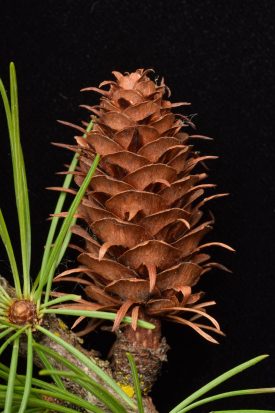UW Botanic Gardens Makes Major Contribution to Tree Book

In February 2020, Vermont-based Dr. W. John Kress was preparing to spend a few weeks at various West Coast arboreta to photograph material for his book, The Smithsonian Guide to Trees of North America.
But the pandemic stymied his travel plans, so he had to suss out how to procure hundreds of live plant samples to photograph in his home studio. While delving into the UW Botanic Gardens’ (UWBG) extensive online database, he realized that the Washington Park Arboretum (WPA) was singularly equipped to provide a lot of the remaining West Coast material needed to photograph for the publication.
As a Distinguished Scientist and Curator Emeritus at the Smithsonian’s National Museum of Natural History and a visiting scholar at the Arnold Arboretum of Harvard University, Kress is very familiar with the UWBG’s “fantastic reputation, with good and diverse material. It’s a great educational place and a great aesthetic place.”
He first contacted his colleague Dr. Richard Olmstead, Professor in Biology and Curator of the Herbarium in the Burke Museum of Natural History and Culture, who put him in touch with Ray Larson, Curator of Living Collections at UWBG. The request included live materials from 50 tree species, many of which were oaks and conifers. The ask was unprecedented in both size and scope: for each species it included flowers, fruits, leaves/needles, seeds and a foot-long portion of a branch–season-permitting, of course.
“It was probably the largest request we’ve ever received, which really speaks to the breadth of our collection and that we can grow so many kinds of trees in our temperate climate,” says Larson. “And we’re unique in that we provide data easily and in great detail to the public. Not just a list with information, but on a map.”
But there was a dilemma: which WPA staff member would have the bandwidth to fulfill such a substantial task, on top of their regular duties?

Serendipity intervened in the form of Wendy Asplin, a UW Continuum College student looking to do an arboretum-related project for her Certificate in Museum Studies. Even more fortuitously, she has a B.S. in Forestry from the UW. “My dendrology class was in the Arboretum in 1975 with Dr. Linda Brubaker,” Asplin explains. “It helped me a lot. I don’t know that I could have done this without that knowledge.”
She spent about 50 hours this May and June collecting in the Washington Park Arboretum. The plant materials needed to be meticulously and gently packaged, kept in a cooler, and labeled before being FedExed overnight within hours of collection.
When Asplin’s samples arrived at Kress’s farmhouse door, “I’d be overjoyed, to say the least,” he recalls. In order to capture the specimens at peak freshness, he would “open the package up and immediately go to work–any time of the day or night that they arrived.”

Asplin credits David Zuckerman, Manager of Horticulture, arborists Clif Edwards and Shea Cole, and plant health specialist Ryan Garrison with invaluable support during her collecting expeditions. They helped confirm tricky IDs, locate tucked-away trees, and climb to access out-of-reach branches and cones.
She recounts an “Indiana Jones” experience with Garrison to find an off-the-beaten-track Pinus halepensis (Aleppo pine): “We went through this thicket of stuff and he had this machete-like thing to cut things away. At one point we’re down on all fours crawling and I said, ‘You know, if you weren’t with me I never would have found this tree.’”
Afterwards, Garrison mentioned that he’d seen some European fire ants in the thicket. “And I said, ‘Oh, is that what I was feeling in there?’ I got home that night and I was covered, like I had the measles! I had been in a t-shirt so anything that was bare skin got bitten. They were not horrible–not like a wasp sting–but they stung. So that was an interesting day for science!”
The Smithsonian Guide to Trees of North America covers 331 species, including 122 genera and 50 families. These species are most of the common trees people will encounter in the US. By including photos of leaves at various times of year and of plant parts not usually depicted in field guides, the book will distinguish itself from similar titles. “I wanted to make sure that the book gives people some idea about the biology of trees as well,” explains the author. “When people look at maples, they don’t know that there are male and female flowers, they just see the fruits or the flowers. And it’s the same with male and female cones in conifers.”
The text thrums with a deeper, more urgent impetus beyond objective description. As Kress states in the preface, the publication is “a call to action in preserving our trees, conserving their habitats and appreciating the forests…It is more important than ever that readers are able to identify with trees in this global era of rapid environmental change.”
The Smithsonian Guide to Trees of North America is scheduled to be published in late 2022 by Yale University Press.